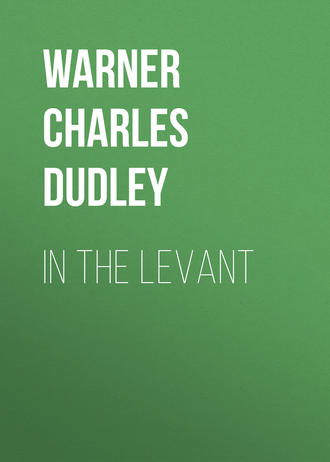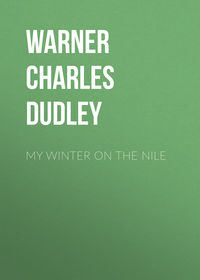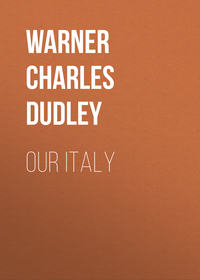 полная версия
полная версияIn The Levant
Perhaps, however, it is best not to have a decent road to the Holy City of the world. It would make going there easy, even for delicate ladies and invalid clergymen; it would reduce the cost of the trip from Jaffa by two thirds; it would take away employment from a lot of vagabonds who harry the traveller over the route; it would make the pilgrimage too much a luxury, in these days of pilgrimages by rail, and of little faith, or rather of a sort of lacquer of faith which is only credulity.
Upon this plateau we begin to discern signs of the neighborhood of the city, and we press forward with the utmost eagerness, disappointed at every turn that a sight of it is not disclosed. Scattered settlements extend for some distance out on the Jaffa road. We pass a school which the Germans have established for Arab boys; an institution which does not meet the approval of our restoration driver; the boys, when they come out, he says, don’t know what they are; they are neither Moslems nor Christians. We go rapidly on over the swelling hill, but the city will not reveal itself. We expect it any moment to rise up before us, conspicuous on its ancient hills, its walls shining in the sun.
We pass a guard-house, some towers, and newly built private residences. Our pulses are beating a hundred to the minute, but the city refuses to “burst” upon us as it does upon other travellers. We have advanced far enough to see that there is no elevation before us higher than that we are on. The great sight of all our lives is only a moment separated from us; in a few rods more our hearts will be satisfied by that long-dreamed-of prospect. How many millions of pilgrims have hurried along this road, lifting up their eyes in impatience for the vision! But it does not come suddenly. We have already seen it, when the driver stops, points with his whip, and cries,—
“Jerusalem!”
“What, that?”
We are above it and nearly upon it. What we see is chiefly this: the domes and long buildings of the Russian Hospice, on higher ground than the city and concealing a good part of it; a large number of new houses, built of limestone prettily streaked with the red oxyde of iron; the roofs of a few of the city houses, and a little portion of the wall that overlooks the Valley of Hinnom. The remainder of the city of David is visible to the imagination.
The suburb through which we pass cannot be called pleasing. Everything outside the walls looks new and naked; the whitish glare of the stone is relieved by little vegetation, and the effect is that of barrenness. As we drive down along the wall of the Russian convent, we begin to meet pilgrims and strangers, with whom the city overflows at this season; many Russian peasants, unkempt, unsavory fellows, with long hair and dirty apparel, but most of them wearing a pelisse trimmed with fur and a huge fur hat. There are coffee-houses and all sorts of cheap booths and shanty shops along the highway. The crowd is motley and far from pleasant; it is sordid, grimy, hard, very different from the more homogeneous, easy, flowing, graceful, and picturesque assemblage of vagabonds at the gate of an Egyptian town. There are Russians, Cossacks, Georgians, Jews, Armenians, Syrians. The northern dirt and squalor and fanaticism do not come gracefully into the Orient. Besides, the rabble is importunate and impudent.
We enter by the Jaffa and Hebron gate, a big square tower, with the exterior entrance to the north and the interior to the east, and the short turn is choked with camels and horses and a clamorous crowd. Beside it stands the ruinous citadel of Saladin and the Tower of David, a noble entrance to a mean street. Through the rush of footmen and horsemen, beggars, venders of olive-wood, Moslems, Jews, and Greeks, we make our way to the Mediterranean Hotel, a rambling new hostelry. In passing to our rooms we pause a moment upon an open balcony to look down into the green Pool of Hezekiah, and off over the roofs to the Mount of Olives. Having secured our rooms, I hasten along narrow and abominably cobbled streets, mere ditches of stone, lined with mean shops, to the Centre of the Earth, the Church of the Holy Sepulchre.
II.—JERUSALEM
IT was in obedience to a natural but probably mistaken impulse, that I went straight to the Church of the Holy Sepulchre during my first hour in the city. Perhaps it was a mistake to go there at all; certainly I should have waited until I had become more accustomed to holy places. When a person enters this memorable church, as I did, expecting to see only two sacred sites, and is brought immediately face to face with thirty-seven, his mind is staggered, and his credulity becomes so enfeebled that it is practically useless to him thereafter in any part of the Holy City. And this is a pity, for it is so much easier and sweeter to believe than to doubt.
It would have been better, also, to have visited Jerusalem many years ago; then there were fewer sacred sites invented, and scholarly investigation had not so sharply questioned the authenticity of the few. But I thought of none of these things as I stumbled along the narrow and filthy streets, which are stony channels of mud and water, rather than foot-paths, and peeped into the dirty little shops that line the way. I thought only that I was in Jerusalem; and it was impossible, at first, for its near appearance to empty the name of its tremendous associations, or to drive out the image of that holy city, “conjubilant with song.”
I had seen the dome of the church from the hotel balcony; the building itself is so hemmed in by houses that only its south side, in which is the sole entrance, can be seen from the street. In front of this entrance is a small square; the descent to this square is by a flight of steps down Palmer Street, a lane given up to the traffic in beads, olive-wood, ivory-carving, and the thousand trinkets, most of them cheap and inartistic, which absorb the industry of the Holy City. The little square itself, surrounded by ancient buildings on three sides and by the blackened walls of the church on the north, might be set down in a mediæval Italian town without incongruity. And at the hour I first saw it, you would have said that a market or fair was in progress there. This, however, I found was its normal condition. It is always occupied by a horde of more clamorous and impudent merchants than you will find in any other place in the Orient.
It is with some difficulty that the pilgrim can get through the throng and approach the portal. The pavement is covered with heaps of beads, shells, and every species of holy fancy-work, by which are seated the traders, men and women, in wait for customers. The moment I stopped to look at the church, and it was discovered that I was a new-comer, a rush was made at me from every part of the square, and I was at once the centre of the most eager and hungry crowd. Sharp-faced Greeks, impudent Jews, fair-faced women from Bethlehem, sleek Armenians, thrust strings of rude olive beads and crosses into my face, forced upon my notice trumpery carving in ivory, in nuts, in seeds, and screamed prices and entreaties in chorus, bidding against each other and holding fast to me, as if I were the last man, and this were the last opportunity they would ever have of getting rid of their rubbish. Handfuls of beads rapidly fell from five francs to half a franc, and the dealers insisted upon my buying, with a threatening air; I remember one hard-featured and rapacious wretch who danced about and clung to me, and looked into my eyes with an expression that said plainly, “If you don’t buy these beads I ‘ll murder you.” My recollection is that I bought, for I never can resist a persuasion of this sort. Whenever I saw the fellow in the square afterwards, I always fancied that he regarded me with a sort of contempt, but he made no further attempt on my life.
This is the sort of preparation that one daily has in approaching the Church of the Holy Sepulchre. The greed and noise of traffic around it are as fatal to sentiment as they are to devotion. You may be amused one day, you may be indignant the next; at last you will be weary of the importunate crowd; and the only consolation you can get from these daily scenes of the desecration of the temple of pilgrimage is the proof they afford that this is indeed Jerusalem, and that these are the legitimate descendants of the thieves whom Christ scourged from the precincts of the temple. Alas that they should thrive under the new dispensation as they did under the old!
A considerable part of the present Church of the Holy Sepulchre is not more than sixty years old; but the massive, carved, and dark south portal, and the remains of the old towers and walls on this side, may be eight hundred. There has been some sort of a church here ever since the time of Constantine (that is, three centuries after the crucifixion of our Lord), which has marked the spot that was then determined to be the site of the Holy Sepulchre. Many a time the buildings have been swept away by fire or by the fanaticism of enemies, but they have as often been renewed. There would seem at first to have been a cluster of buildings here, each of which arose to cover a newly discovered sacred site. Happily, all the sacred places are now included within the walls of this many-roofed, heterogeneous mass, of chapels, shrines, tombs, and altars of worship of many warring sects, called the Church of the Holy Sepulchre.
Happily also the exhaustive discussion of the question of the true site of the sepulchre, conducted by the most devout and accomplished biblical scholars and the keenest antiquarians of the age, relieves the ordinary tourist from any obligation to enter upon an investigation that would interest none but those who have been upon the spot. No doubt the larger portion of the Christian world accepts this site as the true one.
I make with diffidence a suggestion that struck me, although it may not be new. The Pool of Hezekiah is not over four hundred feet, measured on the map, from the dome of the sepulchre. Under the church itself are several large excavations in the rocks, which were once cisterns. Ancient Jerusalem depended for its water upon these cisterns, which took the drainage from the roofs, and upon a few pools, like that of Hezekiah, which were fed from other reservoirs, such as Solomon’s Pool, at a considerable distance from the city. These cisterns under the church may not date back to the time of our Lord, but if they do, they were doubtless at that time within the walls. And of course the Pool of Hezekiah, so near to this alleged site, cannot be supposed to have been beyond the walls.
Within the door of the church, upon a raised divan at one side, as if this were a bazaar and he were the merchant, sat a fat Turk, in official dress, the sneering warden of this Christian edifice, and the perhaps necessary guardian of peace within. His presence there, however, is at first a disagreeable surprise to all those who rebel at owing an approach to the holy place to the toleration of a Moslem; but I was quite relieved of any sense of obligation when, upon coming out, the Turk asked me for backsheesh!
Whatever one may think as to the site of Calvary, no one can approach a spot which even claims to be it, and which has been for centuries the object of worship of millions, and is constantly thronged by believing pilgrims, without profound emotion. It was late in the afternoon when I entered the church, and already the shades of evening increased the artificial gloom of the interior. At the very entrance lies an object that arrests one. It is a long marble slab resting upon the pavement, about which candles are burning. Every devout pilgrim who comes in kneels and kisses it, and it is sometimes difficult to see it for the crowds who press about it. Underneath it is supposed to be the Stone of Unction upon which the Lord’s body was laid, according to the Jewish fashion, for anointing, after he was taken from the cross.
I turned directly into the rotunda, under the dome of which is the stone building enclosing the Holy Sepulchre, a ruder structure than that which covers the hut and tomb of St. Francis in the church at Assisi. I met in the way a procession of Latin monks, bearing candles, and chanting as they walked. They were making the round of the holy places in the church, this being their hour for the tour. The sects have agreed upon certain hours for these little daily pilgrimages, so that there shall be no collision. A rabble of pilgrims followed the monks. They had just come from incensing and adoring the sepulchre, and the crowd of other pilgrims who had been waiting their turn were now pressing in at the narrow door. As many times as I have been there, I have always seen pilgrims struggling to get in and struggling to get out. The proud and the humble crowd there together; the greasy boor from beyond the Volga jostles my lady from Naples, and the dainty pilgrim from America pushes her way through a throng of stout Armenian peasants. But I have never seen any disorder there, nor any rudeness, except the thoughtless eagerness of zeal.
Taking my chance in the line, I passed into the first apartment, called the Chapel of the Angel, a narrow and gloomy antechamber, which takes its name from the fragment of stone in the centre, the stone upon which the angel sat after it had been rolled away from the sepulchre. A stream of light came through the low and narrow door of the tomb. Through the passage to this vault only one person can enter at a time, and the tomb will hold no more than three or four. Stooping along the passage, which is cased with marble like the tomb, and may cover natural rock, I came into the sacred place, and into a blaze of silver lamps, and candles. The vault is not more than six feet by seven, and is covered by a low dome. The sepulchral stone occupies all the right side, and is the object of devotion. It is of marble, supposed to cover natural stone, and is cracked and worn smooth on the edge by the kisses of millions of people. The attendant who stood at one end opened a little trap-door, in which lamp-cloths were kept, and let me see the naked rock, which is said to be that of the tomb. While I stood there in that very centre of the faith and longing of so many souls, which seemed almost to palpitate with a consciousness of its awful position, pilgrim after pilgrim, on bended knees, entered the narrow way, kissed with fervor or with coldness the unresponsive marble, and withdrew in the same attitude. Some approached it with streaming eyes and kissed it with trembling rapture; some ladies threw themselves upon the cold stone and sobbed aloud. Indeed, I did not of my own will intrude upon these acts of devotion, which have the right of secrecy, but it was some time before I could escape, so completely was the entrance blocked up. When I had struggled out, I heard chanting from the hill of Golgotha, and saw the gleaming of a hundred lights from chapel and tomb and remote recesses, but I cared to see no more of the temple itself that day.
The next morning (it was the 7th of April) was very cold, and the day continued so. Without, the air was keen, and within it was nearly impossible to get warm or keep so, in the thick-walled houses, which had gathered the damp and chill of dungeons. You might suppose that the dirtiest and most beggarly city in the world could not be much deteriorated by the weather, but it is. In a cheerful, sunny day you find that the desolation of Jerusalem has a certain charm and attraction: even a tattered Jew leaning against a ruined wall, or a beggar on a dunghill, is picturesque in the sunshine; but if you put a day of chill rain and frosty wind into the city, none of the elements of complete misery are wanting. There is nothing to be done, day or night; indeed, there is nothing ever to be done in the evening, except to read your guide-book—that is, the Bible—and go to bed. You are obliged to act like a Christian here, whatever you are.
Speaking of the weather, a word about the time for visiting Syria may not be amiss. In the last part of March the snow was a foot deep in the streets; parties who had started on their tour northward were snowed in and forced to hide in their tents three days from the howling winter. There is pleasure for you! We found friends in the city who had been waiting two weeks after they had exhausted its sights, for settled weather that would permit them to travel northward. To be sure, the inhabitants say that this last storm ought to have been rain instead of snow, according to the habit of the seasons; and it no doubt would have been if this region were not twenty-five hundred feet above the sea. The hardships of the Syrian tour are enough in the best weather, and I am convinced that our dragoman is right in saying that most travellers begin it too early in the spring.
Jerusalem is not a formidable city to the explorer who is content to remain above ground, and is not too curious about its substructions and buried walls, and has no taste, as some have, for crawling through its drains. I suppose it would elucidate the history of the Jews if we could dig all this hill away and lay bare all the old foundations, and ascertain exactly how the city was watered. I, for one, am grateful to the excellent man and great scholar who crawled on his hands and knees through a subterranean conduit, and established the fact of a connection between the Fountain of the Virgin and the Pool of Siloam. But I would rather contribute money to establish a school for girls in the Holy City, than to aid in laying bare all the aqueducts from Ophel to the Tower of David. But this is probably because I do not enough appreciate the importance of such researches among Jewish remains to the progress of Christian truth and morality in the world. The discoveries hitherto made have done much to clear up the topography of ancient Jerusalem; I do not know that they have yielded anything valuable to art or to philology, any treasures illustrating the habits, the social life, the culture, or the religion of the past, such as are revealed beneath the soil of Rome or in the ashes of Pompeii; it is, however, true that almost every tourist in Jerusalem becomes speedily involved in all these questions of ancient sites,—the identification of valleys that once existed, of walls that are now sunk under the accumulated rubbish of two thousand years, from thirty feet to ninety feet deep, and of foundations that are rough enough and massive enough to have been laid by David and cemented by Solomon. And the fascination of the pursuit would soon send one underground, with a pickaxe and a shovel. But of all the diggings I saw in the Holy City, that which interested me most was the excavation of the church and hospital of the chivalric Knights of St. John; concerning which I shall say a word further on.
The present walls were built by Sultan Suleiman in the middle of the sixteenth century, upon foundations much older, and here and there, as you can see, upon big blocks of Jewish workmanship. The wall is high enough and very picturesque in its zigzag course and re-entering angles, and, I suppose, strong enough to hitch a horse to; but cannon-balls would make short work of it.
Having said thus much of the topography, gratuitously and probably unnecessarily, for every one is supposed to know Jerusalem as well as he knows his native town, we are free to look at anything that may chance to interest us. I do not expect, however, that any words of mine can convey to the reader a just conception of the sterile and blasted character of this promontory and the country round about it, or of the squalor, shabbiness, and unpicturesqueness of the city, always excepting a few of its buildings and some fragments of antiquity built into modern structures here and there. And it is difficult to feel that this spot was ever the splendid capital of a powerful state, that this arid and stricken country could ever have supplied the necessities of such a capital, and, above all, that so many Jews could ever have been crowded within this cramped space as Josephus says perished in the siege by Titus, when ninety-seven thousand were carried into captivity and eleven hundred thousand died by famine and the sword. Almost the entire Jewish nation must have been packed within this small area.
Our first walk through the city was in the Via Dolorosa, as gloomy a thoroughfare as its name implies. Its historical portion is that steep and often angled part between the Holy Sepulchre and the house of Pilate, but we traversed the whole length of it to make our exit from St. Stephen’s Gate toward the Mount of Olives. It is only about four hundred years ago that this street obtained the name of the Via Dolorosa, and that the sacred “stations” on it were marked out for the benefit of the pilgrim. It is a narrow lane, steep in places, having frequent sharp angles, running under arches, and passing between gloomy buildings, enlivened by few shops. Along this way Christ passed from the Judgment Hall of Pilate to Calvary. I do not know how many times the houses along it have been destroyed and rebuilt since their conflagration by Titus, but this destruction is no obstacle to the existence intact of all that are necessary to illustrate the Passion-pilgrimage of our Lord. In this street I saw the house of Simon the Cyrenian, who bore the cross after Jesus; I saw the house of St. Veronica, from which that woman stepped forth and gave Jesus a handkerchief to wipe his brow,—the handkerchief, with the Lord’s features imprinted on it, which we have all seen exhibited at St. Peter’s in Rome; and I looked for the house of the Wandering Jew, or at least for the spot where he stood when he received that awful mandate of fleshly immortality. In this street are recognized the several “stations” that Christ made in bearing the cross; we were shown the places where he fell, a stone having the impress of his hand, a pillar broken by his fall, and also the stone upon which Mary sat when he passed by. Nothing is wanting that the narrative requires. We saw also in this street the house of Dives, and the stone on which Lazarus sat while the dogs ministered unto him. It seemed to me that I must be in a dream, in thus beholding the houses and places of resort of the characters in a parable; and I carried my dilemma to a Catholic friend. But a learned father assured him that there was no doubt that this is the house of Dives, for Christ often took his parables from real life. After that I went again to look at the stone, in a corner of a building amid a heap of refuse, upon which the beggar sat, and to admire the pretty stone tracery of the windows in the house of Dives.
At the end of the street, in a new Latin nunnery, are the remains of the house of Pilate, which are supposed to be authentic. The present establishment is called the convent of St. Anne, and the community is very fortunate, at this late day, in obtaining such a historic site for itself. We had the privilege of seeing here some of the original rock that formed part of the foundations of Pilate’s house; and there are three stones built into the altar that were taken from the pavement of Gabbatha, upon which Christ walked. These are recent discoveries; it appears probable that the real pavement of Gabbatha has been found, since Pilate’s house is so satisfactorily identified. Spanning the street in front of this convent is the Ecce Homo arch, upon which Pilate showed Christ to the populace. The ground of the new building was until recently in possession of the Moslems, who would not sell it for a less price than seventy thousand francs; the arch they would not sell at all; and there now dwells, in a small chamber on top of it, a Moslem saint and hermit. The world of pilgrims flows under his feet; he looks from his window upon a daily procession of Christians, who traverse the Via Dolorosa, having first signified their submission to the Moslem yoke in the Holy City by passing under this arch of humiliation. The hermit, however, has the grace not to show himself, and few know that he sits there, in the holy occupation of letting his hair and his nails grow.
From the house of the Roman procurator we went to the citadel of Sultan Suleiman. This stands close by the Jaffa Gate, and is the most picturesque object in all the circuit of the walls, and, although the citadel is of modern origin, its most characteristic portion lays claim to great antiquity. The massive structure which impresses all strangers who enter by the Jaffa Gate is called the Tower of Hippicus, and also the Tower of David. It is identified as the tower which Herod built and Josephus describes, and there is as little doubt that its foundations are the same that David laid and Solomon strengthened. There are no such stones in any other part of the walls as these enormous bevelled blocks; they surpass those in the Harem wall, at what is called the Jews’ Wailing Place. The tower stands upon the northwest corner of the old wall of Zion, and being the point most open to attack it was most strongly built.





